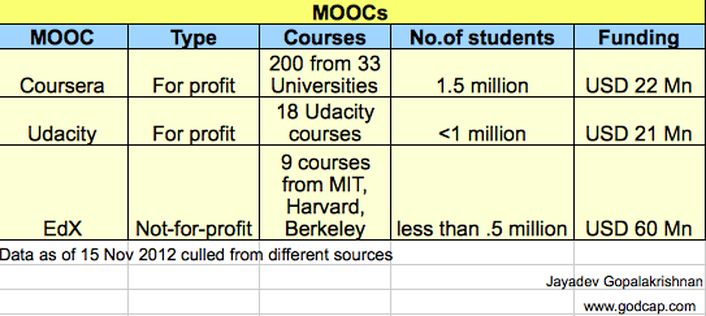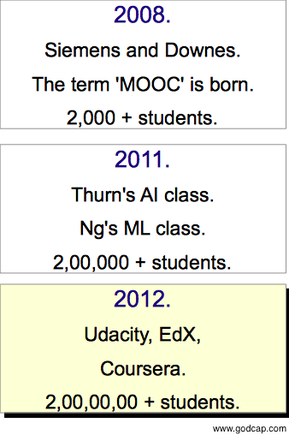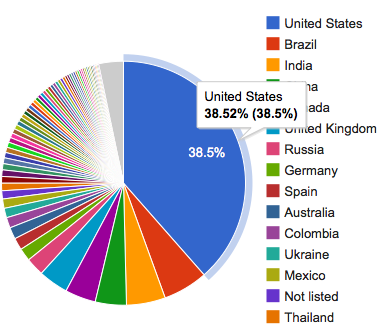Using the core structure of what I presented at the session and additional points, this is a primer on MOOCs in response to several queries on the subject.
Massive Open Online Courses or MOOCs is Higher Education at scale through the internet thereby addressing a very large number of students. There is no registration required at the University, no restriction or barrier to entry and it's free of cost.
You can now take an Ivy League course from your living room without paying a dime (and in some cases, even receive a Statement of Accomplishment).
Wasn't MIT OpenCourseWare initiative around for a decade? What's the difference?
In 1999, MIT decided to open up courses for free and started posting them from 2002. What started with 500 courses has now grown to more than 2000 courses online. In this period, MIT's move inspired several other leading universities to follow suit.
However, there are some key differences between the Open Courseware movement and MOOCs:
1: Structure and level of engagement.
The Open Courseware movement was about opening up content with lectures lending themselves to a large content repository with less emphasis on cohesiveness. Posting lectures, notes, and assignments implied a focus on freeing up otherwise closed information within the system and not on running courses. An individual was meant to pick and choose from a large array of information and learn in isolation. Moreover, many did not know the path to take to reach a desired competency, making the process even more difficult. Though one had the choice of great content to select from, this was not easy in practice. The noise-level was far too high for the average learner.
MOOCs, on the other hand, are structured around multi-week courses specifically meant for online learning with scheduled lectures by professors, quizzes with deadlines, assignments with peer grading, a very high level of community engagement through discussion boards, offline meet ups bringing learners together, and in some cases, a final exam leading to some sort of certification; In other words, a University offering created specifically for the online learner and not just a reproduction of content created within the University system.
2: for profit.
Another significant aspect of the MOOC movement is the emergence of for-profit players with millions of dollars in venture funding. While there are not-for-profit MOOCs like the EdX collaboration between Harvard, Berkley and MIT, for-profit players such as Coursera and Udacity have been pioneering the entry of MOOCs into mainstream culture.
Here is a break-up of some of the popular MOOCs:
Explained using the example of the Gamification course from the University of Pennsylvania that I took on Coursera recently:
- Approx 600 minutes of video lectures with in-video quizzes
- Four Homework quizzes in multiple-choice format
- Three Written Assignments cumulatively not to exceed 2300 words
- Peer grading (5 students X 3 assignments = 15 assignments to be graded)
- A final exam in multiple-choice format
Here is a snapshot of my experience:
- The Professor teaching Gamification was among the first in any global business school to teach this course and has just released a book on the subject.
- The learning process is highly engaging - in-video quizzes pop up to check if you have understood what you have been seeing and hearing.
- The quality of assignments given to me for peer grading was in the range of 'good' to 'very good'. Also, the quality of feedback I received for my submissions were constructive and well thought out.
- Discussions forums are highly active. (You might come across an oddball here and there. Don't we have many of those in traditional college settings too?)
- There is quite a bit of engagement that happens outside the platform. Coursera has 1669 meet-up communities.
At the end, only students with an aggregate score >70% get a Statement of Accomplishment.
Of the 81,000 students who signed up for this course, 8280 students received the certificate (~11%).
A brief history of MOOCs.
To understand MOOCs and their future, let's go back four years when Stephen Downes and George Siemens ran the first Massive course on 'Connectivism and Connected Knowledge' giving rise to the term MOOC.
Where do MOOCs go from here?
The biggest promise of MOOCs is impact.
If we discount a large percentage of the humungous enrolments across the top three MOOCs, we still arrive at a mind-boggling number.
Going back to the Gamification example; this is a hot subject being offered for the first time by the Universiy of Pennsylvania. As mentioned earlier, the professor who teaches the course is the co-organizer of the first-ever Gamification module in a business school and the author of a book on the subject. Around 800 students study at UPenn's Wharton school. Assuming all of them sign up for the Gamification course (unlikely), the impact is 800.
Now compare that figure with 8280 students who completed and received the Statement of Accomplishment for Coursera's MOOC offering of the course. That's 10 X. And that's the scale of impact MOOC brings in - another 7000 + students who otherwise would never have had the chance of taking such a course. Even if you look at the casual learners who form the large majority of those who enrolled, there would have some sort of influence or interest created in them about the subject which could potentially manifest in some form or the other later. Again, this would not have happened had such a platform not existed.
In the medium-term, MOOCs give a chance for a very large set of people to participate in a high-quality learning experience without the worry of costs, distance or background offering a level-playing field in terms of access and consumption of learning. As a learner on MOOC platforms, I can vouch for having experienced some of the best learning I ever had and it has truly kindled my curiosity to learn more. I have even started keeping track of my courses to-do list.
However, where MOOCs need to work on (and this could take a long time) is to generate credible social proof, be it through a credits system or offering certifications that have wide acceptance. Till then, MOOCs will be an extremely rich source of learning for learners across the world - for those studying in institutions with poor access to good quality faculty, for those in part-time jobs, for those in part-time courses and for anyone impacted by the cycle of disruptions (and that includes pretty much all of us growing up in this generation) to navigate through multiple careers. (To know why MOOCs and other emerging platforms have seen such rapid growth in recent times, read my take in an earlier post 'Video killed the radio star').
MOOCs today are driven by self-motivated learners and fit straight into the non-formal, high experiential value, low transaction value quadrant of learning. They have entered our lives at a time when the world is seeing changes of the highest order and job uncertainty is at its worst. People need a credible source of skilling themselves and MOOCs fill that gap as a high-quality source.
In the long term though - once Universities start offering transfer credits and employers start recognizing these certificates - we will see an even more tangible intervention. And this does not look far away. Tier 3 colleges are the ones who are likely to be most affected when this happens as students would rather learn from an Ivy League/Top-tier college with a valid certification to boot than spend 20 X on an institution that is not as popular. Another scenario is that of tier 2 and 3 colleges co-opting MOOCs into their system and giving credits so as to lower their cost of operation as well as the cost of education for the students. Progress is being made in this direction as well.
Impact of MOOCs on Schooling.
MOOCs have a potential impact on the school system as well. Here are a few possible outcomes:
- Extended 'shopping week': School students can take MOOC courses along with school to help determine their field of interest. This is a significant game changer compared to the situation confronting students today where they embark on formal University programmes blindly without any understanding of their 'real' interests.
- Supplementing school education: Schools can make courses on MOOCs as additional compulsory requirements to enhance learning experience and broaden interests of students. In the near future - once a formal system of accreditation is established - Universities can consider these courses for credits.
- A huge leveller: Students can get an early start on the latest topics and emerging trends transcending the disadvantage of an outdated University syllabus.
- Acquiring new skills: A channel for students to acquire new skills without the limitations of bureaucracy or age as a factor for determining 'admission'.
- A new form of networking: Students can leverage this platform to discover and share learning with other like-minded individuals going beyond the usual social networking aspect; this could help fuel entrepreneurial communities / groups working on common goals.
- 'Drop-out' transition: These platforms also help students who have dropped out of formal education systems to keep learning and acquire new skills. This will become ever more significant once a regular accreditation system comes into place.
The India impact:
Compared to any other form of technology intervention in education, India's acceptance of the MOOC phenomenon has been, well, truly phenomenal. For Coursera, the most popular MOOC platform, India is in the top 3 countries in terms of student enrolments.
Any drawbacks?
For MOOCs to truly become a way of life, the industry needs to solve critical issues such as:
1. High drop-out rate: While MOOC sign-ups range from 10,000 to over 100,000 students for a single course, there is a huge drop-out rate compared to traditional University programmes. There are a large number of casual learners and people who 'drop by' compared to those who actually stick out and finish the full course.
2. Plagiarism: How do you prevent cheating in an online environment?
3. Peer Grading: Are your peers 'qualified' to grade your work? How accurate is it compared to the grade a traditional University Prof gives?
4. Accreditation: Are MOOC certificates valid? Unless it results in some sort of credit transfer with other Universities or are recognized by potential employers, what value does it hold?
Another concern that arises is the question whether this is a substitute for the 'real thing' - Higher Education in a traditional college setting with the trappings of a University environment and other intangibles that come along with it?
MOOCs are not meant to be replacements. They are fuelled by the formal education sector. Without Universities doing research, there are no courses to offer and we need the brick-and-mortar classroom with its other components to fund it. MOOCs for a long time to come are extensions to the University system whereby the latter can leverage these platforms to open access to the world as well as use it as a marketing/promotion tool for attracting high-quality students.
MOOCs might not be able to solve the USD 1 Trillion education debt. But one thing is clear. Higher Education is not going to be the same again and MOOCs give us a glimpse into what's coming.




 RSS Feed
RSS Feed